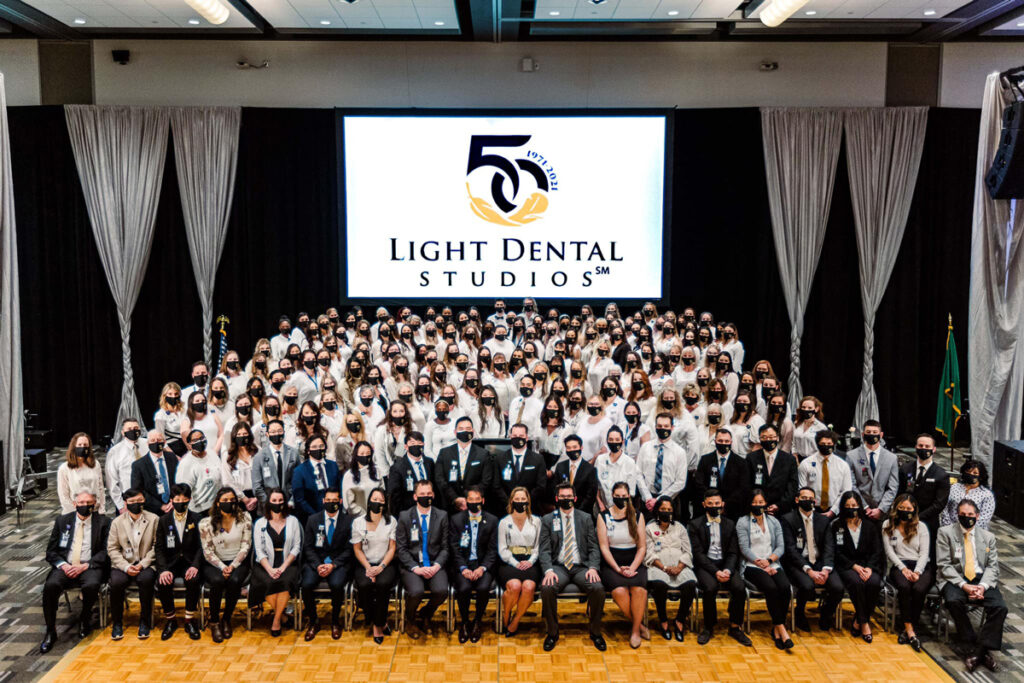Read how these three DEO Members used the Growth Model and its core principles to navigate the stage of growth they are currently in.
By Laura Bowles, DEO
Dental entrepreneurship is a journey filled with unique challenges and opportunities, and no two visions for growing a dental business are alike. But, it is helpful to think of growth as a continuum to figure out where you are, where you need to level up, and where you want to go next. DEO has created a framework where dental leaders can place themselves: “Practice, Business, and Organization”. Here’s an overview of what each of these terms mean.
Practice
At the “practice” stage, a dental group typically has revenues ranging from $1.5 to $10 million, with a workforce size of typically 15 to 50 employees. The owner is often the primary revenue generator, and the business heavily depends on their involvement. The owner might find it challenging to allocate time to work on the business rather than just in it.
Business
At the “business” stage, revenues may range from $5 to $30 million with approximately 25 to 100 employees. The business stage signifies a shift away from the owner being the sole driver of revenue. Leadership may be growing, but the owner often remains the most knowledgeable individual in the company. In the business stage, you’ll have mastered the fundamentals of running a dental practice.
Organization
At the “organization” stage revenues range from $10 to $30+ million with approximately 75 to 500 employees. If you are at this stage, your dental company is mostly self-sustaining, and your absence as the owner won’t disrupt its growth. You have a clear sense of identity and direction. You’ve built the necessary infrastructure to scale and enhance leadership. The ultimate focus at this stage is to create a thriving organization built around a healthy and vibrant culture.
Using this powerful “Practice, Business, and Organization” framework offers a unique way to view the different stages of your dental company’s evolution. Recognizing where your company currently stands will help you identify pain points and chart a path for growth.
DEO wholeheartedly believes that no matter where you are on your dental company’s growth journey, you’ll need to focus on these three key areas to thrive: yourself, your team, and your business. We call this the DEO Growth Model. Armed with the right solutions, you can thrive in these three areas: with you as the leader going from anxiety to confidence; your team going from chaos to momentum; and your business going from fragile to stable; all resulting in more profit, more time for yourself to spend how you want and making more of an impact on your team and community.
Following is a deeper dive so you can identify where you currently fall on the “Practice, Business, Organization” continuum, with illustrations of what the DEO Growth Model areas of you, your team, and your business look like in each stage; common pain points; what you need to solve for to transition to the next stage; plus insights shared by DEO Members navigating within each.
Practice: Growth Depends on You
In essence, being at the practice stage means that your dental business is, to a significant extent, dependent on you, the primary owner, for revenue generation. You are making most of the critical decisions, and while your dedication and hard work have brought you this far, it also means that the business is vulnerable to external factors that might affect your ability to work in it. This vulnerability is one of the defining characteristics of this stage. If something were to happen to you, such as an accident or an unexpected absence, your practice could struggle or even face a downturn.
Your primary role is that of a clinician. However, you’re feeling a strong calling to transition to a role where you are the entrepreneurial driving force of your company. Current state though, you are still focused on the clinical aspects of your company and want to transition to leader/entrepreneur but aren’t sure how.
DEO Member Dr. Trevor Grant, Grant Family Dentistry (1 location), Meeker, CO, who is in the practice stage of growth, says “The reason that I’ve decided to grow is I have a passion for leading and impacting others. I want to provide freedom for the providers which will in turn provide free better care for the patients.”
Your team likely consists of traditional dental roles, including front office staff, dental assistants, and dental hygienists. You may have one or two associates. Marketing might be handled by someone on the team without a clear strategy, or you might have outsourced it to a marketing company. Your primary customer is the patient. Finance support comes from a traditional CPA. An Office Manager may be in place, but their role might not extend to driving practice results or effectively managing the team. Performance reviews may be infrequent, or even non-existent.
Your business at this stage is primarily on clinical systems. Some practices might not use data effectively to understand and drive operations. Setting goals might involve taking last year’s numbers and adding a few extra percentage points. While some practices have goals, the team may not fully understand them. Many owners measure success by looking at the cash in the bank, without a deep understanding of their financial statements. Terms like EBITDA and industry benchmarks might be unfamiliar. The processes for hiring new team members might feel unstructured like every hire is the first time.
Common Pain Points of Dental Entrepreneurs at the Practice Stage
- Overwhelm. You might find yourself in a situation where you’re doing nearly everything yourself. The weight of running the practice falls largely on your shoulders, leaving you feeling overwhelmed and, at times, burnt out.
- Limited Delegation. Often entrepreneurs in this stage express frustration with the belief that no one can handle tasks as effectively as they can. Delegation and trust are often issues that need addressing.
- Time Constraints. A practice owner often feels the lack of time to think, strategize, or even train team members effectively. The daily grind can leave little room for working on the business instead of just working in it.
- Team Challenges. Finding and retaining high-quality team members can be a considerable challenge. You might be struggling to build a cohesive, high-performing team that shares your vision for the practice.
- Lack of Direction. If you mostly identify with this stage you may be grappling with questions like, “Where do I even start?” and “How do I get out of the dental chair and maintain revenue?” There’s a pressing need for guidance and a clear path forward.
Dr. Grant notes “I feel like we’re halfway between the practice and the business. The biggest piece I feel like I’m missing and why I’m stuck at the practice level is that the primary source of income is still generated by my hands. I’m working on changing that. I’m still trying to figure out when I can bring in a second associate to get me further out of the chair and still have a paycheck.”
Top 5 Challenges to Solve Before Transitioning to the Business Stage
To break through and transition from a practice to the business stage, you’ll need to solve certain challenges and employ successful business principles. DEO calls these the Growth 30, core principles for you, your team, and your business. Following are some of the prescriptive recommendations curated from the Growth 30:
No. 1: Leadership Development. Invest in developing your leadership skills with self-awareness about where you can grow and improve, including increasing your “emotional intelligence.” Learning how to better manage your time is essential too. Make time to focus on and prioritize the strategic aspects of your business, such as setting clear goals, creating systems, and refining your business strategy.
No. 2: Delegation and Team Building. Overcome the “I must do it all” mentality by building a high-performing team that shares your vision and values. Learn to delegate effectively and trust your team members. Creating a basic org chart will be helpful here as well as performing quarterly check-ins with each team member to identify areas of improvement and opportunities for career development.
No. 3: Strategic Marketing. Develop a comprehensive marketing strategy that goes beyond the basics. Understanding your patient avatar and creating a roadmap for a superior patient experience is essential.
No. 4: Financial Understanding. Invest in understanding your financials like your P&L, critical metrics like EBITDA, and analyze your spending against industry benchmarks.
No. 5: Systemization. Begin documenting and developing systems for every process in your company from front office to HR. It’s a big undertaking – start with hiring and onboarding new team members to make the biggest impact. For example, incorporating the Kolbe work personality index to each current and new team member to foster understanding and a better workplace culture.
By following these recommendations curated from DEO Growth 30, Dr. Grant’s company is making progress in solving the practice stage challenges: “We are essentially building all of the systems that we need to scale. When we scale, I want to have everything completely in place … I am learning how to have difficult conversations in a positive way … Very recently we built out all of our onboarding processes and built our clinical standards as we brought in an associate. We have a brand-new team so I’d say those systems are working well.”
Business: Balancing Between Entrepreneur and CEO
At this stage, you’ve likely left the initial hustle behind and you’ve made the fundamental shift from being the sole driver of revenue as the owner to developing a more robust and self-sustaining business model. You might have added a couple or more associates and possibly even opened multiple locations.
As the founder and entrepreneur, you’re now constantly learning, acquiring new skills, and adapting at this stage. While your business is growing, your income may have taken a hit. You’re wrestling with the question of how to pay yourself when revenue is no longer directly linked to your clinical work. Your confidence may fluctuate and you’re working harder than ever, yet it might feel like progress is slow.
Your team is shifting the focus from the front-line team serving patients to building leaders who can manage those teams. Your leadership team is now composed of individuals who have been with you for a while, and individual contributor employees are often transitioning to managers. They now see the bigger picture, and it’s your responsibility to foster this growth. You’re also recognizing the need to develop practice managers and associates, further deepening the talent pool within your organization.
Your business focus shifts from being patient-centric to becoming team-centric, a significant transition in your journey. Some tasks may start to centralize for efficiency, consistency, and scale, requiring effective delegation and team collaboration. While you may have implemented some systems earlier on, they’re not fully streamlined at this stage. You are focused on reducing redundancies and optimizing resources. Financially, as noted, perhaps your income has decreased and you’re figuring out how to pay yourself. You have equipped yourself with the essential financial knowledge necessary to navigate the complexities of growing your company.
DEO Member Dr. Marc Adelberg, CEO of Adelberg Montalvan Pediatric Dental (4 locations), is in the business stage of growth. “Our ‘why’ is most important,” he said. “It’s our guiding light … Our ‘why’ is to make a positive impact in a child’s life forever. That ‘why’ drives us all the time when we answer our phones, how can we make you smile? And that can be taken figuratively or literally. So we might make your smile, make your teeth look better … but also the patient experience…”
Common Pain Points in the Business Stage
- Learning Curve Overload. The shift from clinician to entrepreneur means mastering a wide range of skills, from finance and marketing to HR and business development. This steep learning curve can be overwhelming.
- Isolation and Confidence. Entrepreneurs may feel isolated and lacking in confidence as they navigate their growing leadership role.
- Hard Work with Uncertain Progress. Working tirelessly without a clear sense of progress can be frustrating. There are high highs and low lows, and it’s common to try new strategies that may not always succeed.
- Building a Strong Team. Shifting focus from patient care to building your leadership team is crucial for growth. Identifying and developing practice managers and associates is a significant challenge.
- Systems and Technology Integration. The need for technology with automation, and more systems increases, but integrating various platforms and training teams can be difficult. Maybe you are implementing revenue cycle management, HRIS, LMS, etc. but it’s not smooth sailing.
Dr. Adelberg notes: “So the organization stage is where I would like us to be … But, we’re a little bit all over the map … We have owners still doing clinical work … We have associate development but not really a specific program for them … We have been diving into a lot more KPIs and systems now, but there are other times we’re just collecting data…”
Top 5 Challenges to Solve Before Transitioning from Business to Organization
Moving from the business stage to the organization stage is a substantial leap. To make this transition successful, consider the following prescriptive recommendations curated from the core principles of the DEO Growth 30:
No. 1: Change Your Mindset. Transitioning from business owner to organization leader requires you to embrace the idea that your role is no longer limited to being the driving force of the company. It’s about building a team of capable individuals who can carry the torch forward. Creating a vision that inspires your team is key.
No. 2: Establish Robust Systems. You’ll need to establish strong, efficient systems that underpin every aspect of your company. They should promote consistency, streamline operations, and facilitate scalability from appointment scheduling to patient records management. Implementing a project strategy approach called IDOPE (Idea, Document, Organize, Prioritize and Execute) will be helpful for your team.
No. 3: Develop a Leadership Team. This is essential. Identify individuals within your organization who show leadership potential such as your practice managers, associates, and others, and invest in their development. KPIs take center stage and allow you to connect with, measure their progress for accountability and motivation, and coach your team, all so you can delegate more and focus on strategic initiatives.
No. 4: Utilize Tools and Strategies. These run the gamut from HR to technology and there are unique tools you can leverage to drive your growth into an organization. Consider implementing time-blocking to drive productivity, clearly defining your associate avatar, and technology automation to optimize operations.
No. 5: Address Financial Aspects. As you transition to an organization, you’ll need to revisit your financial structure. For example, develop a 13-week cash flow projection to ensure financial stability. It’ll be time to pay close attention to revenue cycle management to optimize cash flow. This stage might also involve reevaluating your legal structure to align with your company’s new needs.
By following these recommendations curated from DEO Growth 30, Dr. Adelberg’s company is making progress in solving business stage challenges. “We excel at clinical consistency,” he said. “We have a great P&L and great percentages … As CEO, I’m learning how to delegate and let go and let our leaders do what they do best … but also understand why I should delegate.”
Becoming a “Thriving” Organization
At this stage, your dental company is self-sustaining, and your absence as the owner won’t disrupt its growth. You have a clear sense of your identity and direction. You’ve got the basics right, but now it’s about refining and perfecting. Your ultimate goal is to create a thriving organization with a great culture.
You, as the leader, are transitioning from an entrepreneur to a bonafide CEO, as a visionary for your company. In this organization stage, your focus shifts from day-to-day operations to high-level strategic thinking and discipline, and you’re exploring what’s next for your journey. You’re comfortable running the show, but you might also be contemplating a transition or exit strategy. Your primary focus at this stage is on the long-term vision both for yourself and your dental company.
Your team undergoes a significant shift in the organization stage. True executive leaders, experts in their respective fields, are now leading distinct departments within your dental company like marketing, finance, operations, revenue cycle management, HR, clinical, and more. Mid-level managers may be added between the executive team and the practice-level team. You invest heavily in leadership development. Your team is no longer just a group of individuals; it’s a well-oiled machine, with everyone playing their designated role.
DEO Member Dr. Steve Broughton, CEO of Light Dental Studios (22 locations), who is building a thriving organization, says “It has given me so much meaning in my life … It’s the human beings that I’ve gotten to do this with over time. I always say the best thing that a leader can do is live your life by example … And that example does permeate through your organization … there’s stability … our company is really dedicated to the development of people. We have these three different pathways for leadership.”

Your business focus also evolves in the organization stage. Your primary customer focus shifts from external patients to your internal team and doctors. Marketing efforts now concentrate on creating an attractive employer brand to entice potential doctors. Recruiting top talent, associate development, and compliance are essential. You are zoning in on methods for driving sales growth and integrating new dental offices culturally, financially, clinically, and operationally. Your business’s strategic planning is more sophisticated, and decision-making is based on data and analytics. Technology and data benchmarking are increasingly utilized to make your company more efficient, effective, and profitable.
Common Pain Points in the Organization Stage
While reaching the organization stage is an achievement to be proud of, it’s not without its challenges and introduces new additional pain points for reaching the next goal post of being a thriving organization, like:
- Balancing the Transition from Entrepreneur to Visionary CEO. Shift from hands-on entrepreneurship to high-level executive responsibilities is challenging. Planning for “what’s next” adds complexity as you consider transitions and exits.
- Connection and Communication Challenges. It’s becoming more difficult to maintain connections with the solo practitioners and your team, which may feel uncomfortable while you’re focusing on high-level business discussions and board presentations.
- HR is Critical. Identifying, recruiting, and retaining top-tier executives to lead departments is difficult. A team whose primary focus is quality control and assurance is needed to grow to the next level.
- Customer Focus Evolving. You’re shifting the primary customer focus from patients to your team and doctors require advanced strategic planning and decision-making systems. You’ll be navigating the complexities of leadership development, recruiting, associate development, and compliance.
- Marketing Transformation. Marketing strategies need to not only attract new patients but to build a compelling employer brand that attracts potential doctors.
- Tech Stack and Custom Software. It’s hard managing a defined technology stack and you are probably considering the need for custom software or integrations to support operations and growth.
- De Novo Development and Acquisition Strategies. Successfully taking a new dental office from concept to profitability within a specific timeframe involves multiple complexities. Formulating effective strategies for acquiring new offices is required to ensure a seamless integration culturally, financially, clinically, and operationally.
Dr. Broughton notes “The bulk of our expenses are sitting in labor and it’s rising rapidly …. We also have turnover… it’s mostly in the first year, but still it’s turnover.”


Top 5 Challenges You Will Be Constantly Solving to Be a “Thriving” Organization
Growing in a “thriving” organization is no small feat and there will always be challenges. To solve them, here are just some of the prescriptive recommendations curated from the core principles of the DEO Growth 30:
No. 1: Creating a Visionary Roadmap. Develop a comprehensive strategy plan that outlines short-term and long-term goals. This strategy alignment should include market analysis, competitive positioning, and ensuring every team member understands and supports its vision.
No. 2: Wisely Choose Your Partners. Partner alignment and selection is key. Conduct thorough due diligence when selecting partners. Clearly define roles, responsibilities, and expectations in partnership agreements. Regular communication and alignment meetings are essential. Choose the right partners and associates who align with your organization’s culture and vision.
No. 3: Robust Financial Plan and Exit Strategy. Work closely with experts on financial planning exit expectations and otherwise. This includes assessing your company’s current financial health, optimizing revenue streams, and planning for tax implications. An optimized balance sheet, capital for growth, and equity structure will be key for financial planning as well.
No. 4: Elevate Patient Experience through Call Centers. Invest in leadership development and implement KPIs to measure call center efficiency, customer satisfaction, and appointment scheduling. Regular training and feedback can enhance their performance. Front desk call center leadership and metrics are non-negotiable going forward.
No. 5: Centralizing Services and Technology Automation. Streamlined and efficient operations are a “must-have’’ for continued growth. Technology automation through custom software can aid centralization. It may be required to be creative to solve labor needs such as considering offshore teams.
By following these recommendations curated from DEO Growth 30, Dr. Broughton’s company is making progress on the continuingly evolving challenges of striving to be a “thriving” organization: “We’re looking at the problem of rising labor by considering different compensation models for hygiene … We’re redoing how we’re training our front office people … We are creating a transition and succession plan …. With acquisitions that are not performing very well, as the CEO, I’ve learned to stick with it, give it a lot of time and love, and get people in there who have a passion for solving whatever that particular acquisition issue with that acquisition is. And, then we figure it out…”
So where do you fit on the “Practice, Business, and Organization” continuum? Perhaps these common pain points and top challenges of each stage resonate with you. To thrive, dental leaders must focus on themselves, their teams, and their businesses, as prescribed by the DEO Growth Model. Doing so will result in more profit, more time, and making more of an impact. It’s a journey of constant adaptation and learning and DEO is glad to be by your side. To learn more about the DEO Growth Model, DEO Growth 30, and all that DEO membership offers, click here.






